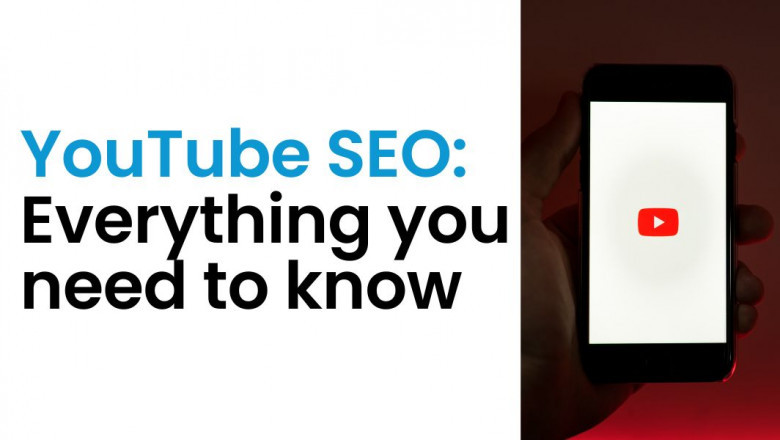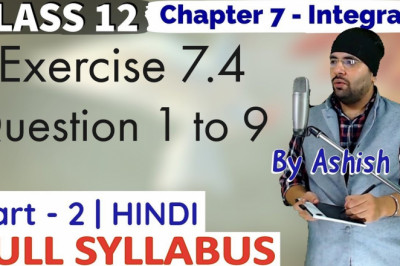views

Are you looking to get your YouTube videos to rank higher in search results? If so, this complete guide to SEO for YouTube videos is for you. We’ll cover how Youtube SEO can be helpful for brands, how Google prioritizes YouTube videos in search results, the role of YouTube video tags in ranking your video higher in search results, and which SEO tool is best for YouTube. Plus, we’ll give you 10 tips for YouTube SEO that you can start using right away to improve your rankings.
How YouTube SEO can be Useful for Brands
YouTube is the second largest search engine, handling over 3 billion monthly searches. That’s a lot of potential traffic that brands can tap into. But how do you make your YouTube videos rank higher in search results? That’s where SEO comes in.
Youtube SEO, or search engine optimization YouTube, is the process of optimizing your videos to rank higher in YouTube’s search results. There are a few benefits of ranking higher in YouTube’s search results:
Increased traffic: The higher your video ranks in YouTube’s search results, the more likely people are to find and watch your video.
Increased brand awareness: A higher ranking in YouTube’s search results will also increase brand awareness. As more people see your video in YouTube’s search results, they’ll be more likely to remember your brand.
Improved leads and sales: Ultimately, the goal of any business is to generate leads and sales. And while ranking higher in YouTube’s search results won’t necessarily lead to an immediate increase in leads and sales, it will put your brand in front of a larger audience which could eventually lead to more business.
So, now that we’ve gone over some of the benefits of SEO for YouTube let’s look at how Google prioritizes YouTube videos in search results.
How Google Prioritizes YouTube Videos in Search Results
To determine how to rank videos in search results, YouTube looks at various factors. For example, the relevancy of your video’s title, description, and tags are assessed to match your video with relevant searches. YouTube also looks at how often and for how long viewers watch your video and the number of likes, comments, and shares. These factors signal YouTube about your video’s quality and help it determine where to rank it in search results.
YouTube also looks at the overall engagement of your channel. If your channel has a high number of subscribers, YouTube will give your videos a boost in search results. This is because YouTube wants to surface videos from channels that viewers are likely interested in. If you have a new channel with few subscribers, don’t worry – YouTube will still surface your videos in search results if they’re high quality and relevant to the viewer’s search.
Here are a few things you can do to optimize your videos for SEO:
- Use keyword-rich titles: Include relevant keywords in your video’s title so that it shows up when people search for those keywords.
- Optimize your video’s description: Write a long, keyword-rich description for your video and include links to your website or other social media channels.
- Use tags: Tags are keywords you can associate with your video. YouTube uses these tags to understand the topic of your video and match it with relevant searches.
- Create transcripts of your videos: Transcripts can help YouTube understand the content of your video and match it with relevant searches. They can also be used to create closed captions for your video.
- Optimize your thumbnail image: Your thumbnail image should be high quality and give viewers a preview of what your video is about.
- Promote your videos on other channels: Help YouTube understand that your video is high-quality and relevant by promoting it on your website, blog, and social media channels.
Following these tips can help YouTube understand your video and rank it higher in search results.
The Role of YouTube Video Tags in Ranking Your Video Higher in Search Results
YouTube tags are one of the most important ranking factors for your YouTube videos. Tags are essentially keywords that describe your video and help YouTube understand what your video is about. The more relevant and accurate your tags are, the higher your video will rank in YouTube search results.
Tags also help YouTube recommend your video to users who are watching similar videos or searching for videos on similar topics. So, using various relevant tags to reach the widest audience possible is essential. Finally, don’t forget to include your target keyword in your video tags. This will not only help your video rank higher in YouTube search results but also help your video rank higher in Google search results.
YouTube SEO: Best tools
Many different SEO tools are available for optimizing YouTube videos, but which is the best?
Here are our top 10 youtube SEO tools:
- TubeBuddy: TubeBuddy is a free YouTube channel management and optimization tool with a chrome extension and a web app. Its features include keyword research, video tags, thumbnail optimization, and more.
- VidIQ: VidIQ is another popular YouTube optimization tool available as a Chrome extension and web app. It has features helping with keyword research, video tags, and more.
- VidStatsX: vidStatsX is a free YouTube analytics tool that provides detailed information about YouTube videos, channels, and users.
- YouTubers Journey: YouTubers Journey is a free YouTube course that covers everything from YouTube algorithm changes to tips for growing your channel.
- YouTube Keyword Tool: The YouTube Keyword Tool is a free online tool that helps you find keywords for your videos.
- Google AdWords Keyword Planner: The Google AdWords Keyword Planner is a free online tool that lets you find keywords for your YouTube videos.
- Hootsuite Insights: Hootsuite Insights is a paid social media analytics tool that includes YouTube analytics.
- Social Blade: Social Blade is a free online platform that provides YouTube analytics and insights.
- Video: Vidooly is a paid YouTube marketing and optimization tool that includes features like video tags, thumbnail optimization, and more.
- YouTuber Analyzer: YouTuber Analyzer is a free online tool that provides YouTube analytics and insights.
10 best tips for YouTube SEO
- Optimize your video titles for both search engines and viewers.
- Write compelling descriptions.
- Use keywords throughout your video.
- Choose an attractive thumbnail.
- Optimize your videos for search engine algorithms.
- Promote your videos across the web.
- Use annotations and end screens.
- Encourage engagement with your videos.
- Create transcripts of your videos.
- Monitor your progress.
Tools for SEO
There are a lot of different tools that can be useful for search engine optimization. Here are some of the most popular ones:
- Google Search Console: This is a free tool provided by Google that helps you track your website’s performance in search results. It also includes data that can help you improve your website’s ranking.
- Google Analytics: This is another free tool from Google that provides detailed data about your website’s traffic. It can be beneficial for understanding where your website’s visitors are coming from and how they interact with your site.
- Moz: This paid tool provides a lot of data and features to help you improve your website’s ranking. It includes features such as keyword research and link analysis.
- Ahrefs: This is a paid tool similar to Moz but focuses more on link analysis.
- SEMrush: This paid tool provides data about your website’s performance in the search results and about your competition.
Tips for SEO optimization
SEO optimization is one of the most important things to do for your website. It’s not just about making sure that you’re ranking on Google and Bing—it’s also about making sure that you have great content so people stay on your site long enough to find what they’re looking for.
Here are some tips for SEO optimization:
- Optimize your website for mobile devices.
- Use relevant and unique titles and descriptions.
- Use a variety of keyword types.
- Optimize your images.
- Use internal linking.
- Publish high-quality content regularly.
- Promote your content.
- Monitor your SEO progress.












